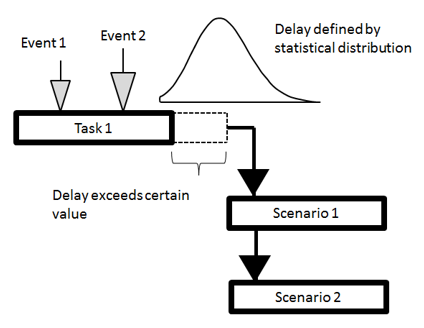In project risk analysis, conditional and probabilistic branching are methods we can use to evaluate different scenarios and decision points that can occur during project execution. Conditional branching involves creating different project paths based on specific conditions or criteria, such as meeting a deadline or passing a test. Probabilistic branching, on the other hand, uses probabilities to determine the likelihood of various outcomes, allowing project managers to anticipate and plan for different scenarios. Let’s take a look at a couple of simple examples
Our first example is conditional branching, where we can analysis where certain scenarios are und when a task meets certain conditions. For example, the duration of a task is affected by two events and uncertainty defined by a statistical distribution. These will cause a delay in the task. If the delay is greater than a certain value, then Scenario 1 will be selected. If the delay is less than certain value, then Scenario 2 will be selected. This allows us to set the rules under which certain alternatives or branches will be run based on whether the task meets a specific condition. Branching can be also done using cost, work, task finish times and other parameters. This is useful in cases in which we will have to make a choice based on a condition that can occur. A common example of this occurs in development, when if a component is not available in time, the project will switch to an existing technology that they have available.
Conditional Branching
There is also another version of branching – probabilistic. In this version, we can select branches based on probability rather than a condition and can be selected randomly based on certain chance rather than duration, finish time, or cost. In our example there is 60% chance that scenario 1 will be executed and 40% chance that scenario 2 will be executed. This is called probabilistic branching. It can be useful when we want to choose different scenarios based on random factors outside of our control. This is often used to model testing activities especially when there is historical data on failure rates. If a scheduled test passes one branch is selected, if it fails another branch is selected. For example, in a pipeline, certain sections may fail inspections and need to have connections redone for retesting.
Probabilistic Branching
To wrap things up, conditional and probabilistic branching cab provide useful analysis of possible project outcomes by modeling different scenarios and decision points, and help you keep your project on track. Whether you’re setting specific conditions or using probabilities, these methods give you a solid way to tackle risks and ensure things run smoothly.



